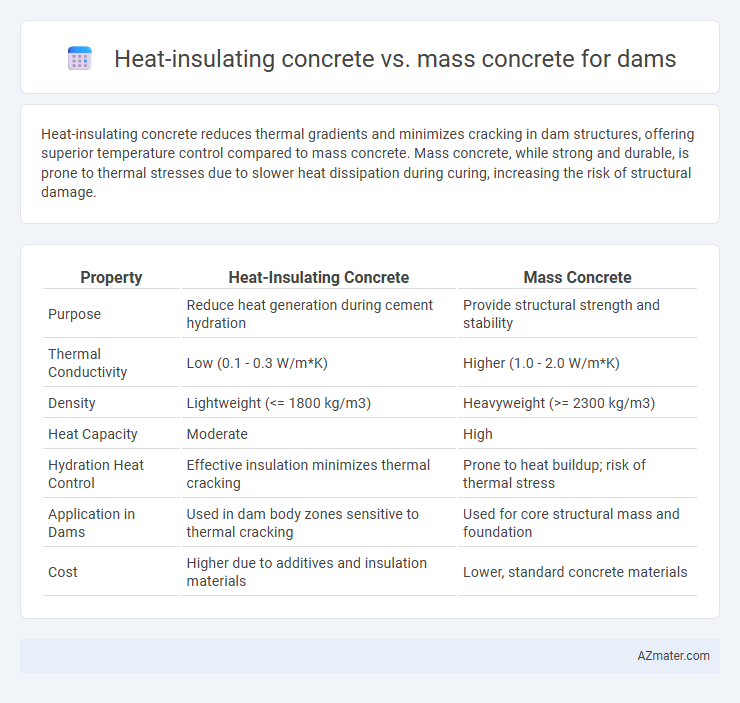Heat-insulating concrete reduces thermal gradients and minimizes cracking in dam structures, offering superior temperature control compared to mass concrete. Mass concrete, while strong and durable, is prone to thermal stresses due to slower heat dissipation during curing, increasing the risk of structural damage.
Table of Comparison
| Property | Heat-Insulating Concrete | Mass Concrete |
|---|---|---|
| Purpose | Reduce heat generation during cement hydration | Provide structural strength and stability |
| Thermal Conductivity | Low (0.1 - 0.3 W/m*K) | Higher (1.0 - 2.0 W/m*K) |
| Density | Lightweight (<= 1800 kg/m3) | Heavyweight (>= 2300 kg/m3) |
| Heat Capacity | Moderate | High |
| Hydration Heat Control | Effective insulation minimizes thermal cracking | Prone to heat buildup; risk of thermal stress |
| Application in Dams | Used in dam body zones sensitive to thermal cracking | Used for core structural mass and foundation |
| Cost | Higher due to additives and insulation materials | Lower, standard concrete materials |
Introduction to Dam Construction Materials
Heat-insulating concrete improves thermal regulation in dam structures by reducing temperature-induced stresses, enhancing durability compared to traditional mass concrete. Mass concrete, characterized by its large volume and thermal capacity, requires careful temperature control to prevent cracking during curing. Selecting between heat-insulating and mass concrete depends on balancing thermal management needs with structural stability in dam construction materials.
Overview of Heat-Insulating Concrete
Heat-insulating concrete used in dam construction incorporates lightweight aggregates and thermal insulation materials to reduce heat generation from cement hydration, minimizing thermal cracking risks. This concrete type maintains structural integrity by controlling temperature gradients during curing, unlike traditional mass concrete which relies on slow cooling and thermal diffusion. Optimized thermal properties and improved durability make heat-insulating concrete a preferred choice in hydraulic engineering projects requiring large-volume pours.
Overview of Mass Concrete
Mass concrete is a critical material for dam construction, characterized by its large volume and ability to withstand substantial compressive forces. Its thermal properties are essential in controlling heat generation and dissipation during curing to prevent thermal cracking. The dense composition and low permeability of mass concrete ensure structural integrity and durability under varying environmental loads.
Thermal Properties Comparison
Heat-insulating concrete exhibits significantly lower thermal conductivity, typically around 0.5 W/m*K, compared to mass concrete, which ranges from 1.4 to 2.0 W/m*K, enhancing its ability to reduce heat transfer and thermal gradients within dam structures. This reduced heat transfer minimizes the risk of thermal cracking and ensures more uniform temperature distribution during the curing process. Mass concrete's higher thermal conductivity causes faster heat dissipation but increases internal stresses due to temperature differentials, potentially compromising dam durability.
Structural Performance Analysis
Heat-insulating concrete offers superior thermal regulation, reducing temperature gradients and minimizing thermal cracking in dam structures compared to mass concrete. Structural performance analysis reveals that heat-insulating concrete enhances durability by controlling internal stresses and improving resistance to freeze-thaw cycles. Mass concrete, while providing substantial compressive strength, is more susceptible to thermal cracking due to slower heat dissipation and greater differential temperatures within the dam body.
Impact on Crack Resistance
Heat-insulating concrete for dams enhances crack resistance by reducing thermal gradients and minimizing thermal stresses during curing and temperature fluctuations. Mass concrete, with its higher thermal capacity, tends to develop internal temperature differentials that increase the risk of thermal cracking. Utilizing heat-insulating concrete improves durability and structural integrity by maintaining more uniform temperature distribution within large dam sections.
Durability and Longevity Factors
Heat-insulating concrete offers enhanced durability for dams by reducing thermal cracking through controlled temperature gradients, thereby minimizing stress-induced damage compared to mass concrete. Mass concrete, while structurally robust, is prone to thermal cracking and shrinkage, potentially compromising long-term stability and increasing maintenance needs. The integration of heat-insulating additives and admixtures in concrete significantly extends the dam's operational lifespan by improving resistance to environmental degradation and thermal stress.
Construction Techniques and Challenges
Heat-insulating concrete for dam construction involves specialized techniques such as incorporating insulating materials like perlite or expanded polystyrene to reduce thermal gradients, which helps prevent thermal cracking during curing. Mass concrete requires careful temperature control through methods like cooling pipes and staged pour sequences to dissipate heat generated by cement hydration, addressing challenges related to internal thermal stresses. Both methods demand precise quality control and monitoring to ensure structural integrity, but heat-insulating concrete offers improved thermal performance at the cost of increased material complexity and cost.
Cost Implications and Economic Viability
Heat-insulating concrete reduces cooling time and thermal cracking risk in dam construction, leading to lower maintenance and repair costs compared to mass concrete. While heat-insulating concrete has higher initial material expenses, the overall economic viability improves through accelerated construction schedules and enhanced durability. Mass concrete offers lower upfront costs but may incur additional expenses due to thermal stress management and extended curing periods.
Conclusion: Optimal Choice for Dam Projects
Heat-insulating concrete offers superior thermal regulation and reduces thermal cracking risks, making it ideal for large dam structures exposed to variable temperatures. In contrast, mass concrete provides excellent structural strength but requires careful management of heat generation during curing to prevent damage. Selecting heat-insulating concrete enhances durability and long-term stability, positioning it as the optimal choice for most dam projects.

Infographic: Heat-insulating concrete vs Mass concrete for Dam
 azmater.com
azmater.com